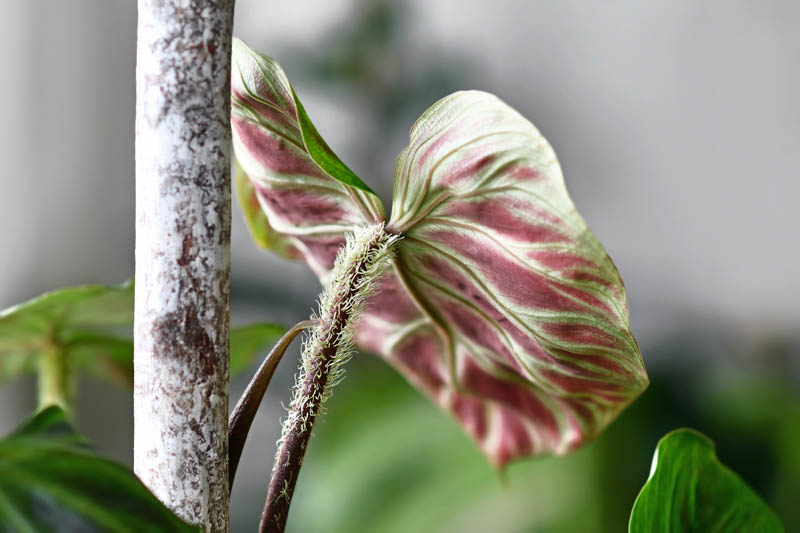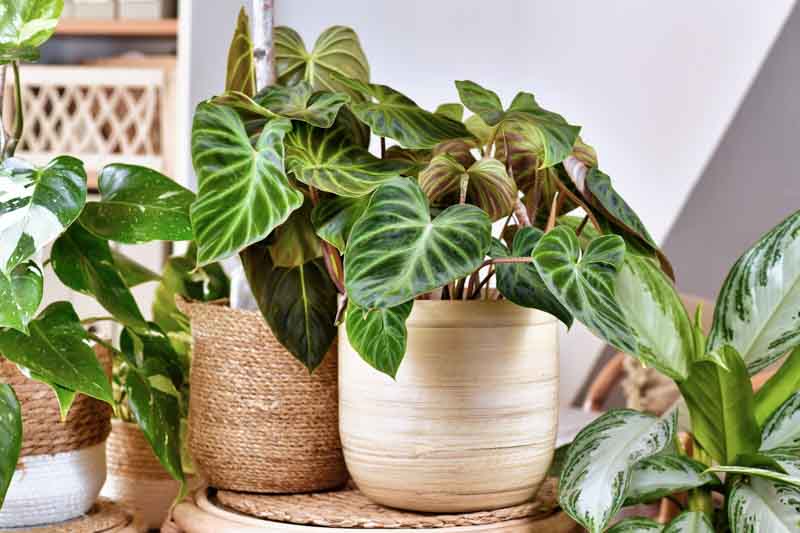Philodendron verrucosum, a captivating species within the vast Philodendron genus, is celebrated for its extraordinary beauty and intriguing textures.
Philodendron verrucosum is distinguished by its large, heart-shaped leaves that boast a velvety texture and vibrant coloration. The leaves are deep green on the surface, with contrasting veins that can appear almost white or light green, creating a striking visual effect. The undersides of the leaves are a rich, maroon color adorned with fuzzy orange petioles, adding to the plant’s unique appeal.
Native: This plant, native to the tropical rainforests of Central and South America, particularly Ecuador and Colombia, thrives in the humid, understory layers of the rainforest, where it receives dappled sunlight and is protected from the harsh, direct rays of the sun. It belongs to the arum family (Araceae), along with Zantedeschia (Calla Lily), Caladium (Angel Wing), Monstera (Swiss Cheese Plant), or Colocasia (Elephant Ear).
Plant Type and Habit: Philodendron verrucosum is a hemiepiphyte, meaning it can grow either as a terrestrial plant or as an epiphyte, attaching itself to trees with aerial roots in search of light. In cultivation, it is often grown in pots with support to mimic its natural climbing habit, showcasing its sprawling foliage.
Size: When grown indoors with adequate support, Philodendron verrucosum can reach heights of 3 feet (90 cm), with a spread of 2 feet (60 cm), depending on the growing conditions and the space provided for its aerial roots to extend.
Flowers: Like many Philodendrons, verrucosum can produce flowers, though this is a rare sight in indoor environments. The flowers consist of a spadix surrounded by a spathe, characteristic of the Araceae family. However, the plant is primarily cultivated for its spectacular foliage rather than its floral display.
Foliage: The foliage of Philodendron verrucosum is its standout feature. Each leaf is a masterpiece, with velvety surfaces that beg to be touched and dramatic veining that catches the eye. The contrast between the dark green tops and the maroon undersides, coupled with the orange-hued petioles, makes this plant a true showstopper in any collection.
Hardiness: It is best suited to USDA hardiness zones 10-12 if grown outdoors.
Uses: Philodendron verrucosum is primarily used for ornamental purposes, thanks to its stunning appearance. It is a popular choice for adding a touch of the exotic to interior spaces, whether displayed in living rooms, greenhouses, or offices.
Toxicity: Philodendrons are toxic to humans, cats, and dogs if ingested. They contain calcium oxalate crystals that can cause mouth and stomach irritation. Contact with the sap may cause skin irritation.
Deer and Rabbits: Its toxicity generally deters deer and rabbits.
Benefits: Beyond its decorative value, it also contributes to a healthier indoor environment by purifying the air, making it a functional and a beautiful addition to homes and workplaces.

Light: Prefers bright, indirect light. Direct sunlight can scorch its velvety leaves, while too little light can lead to leggy growth and less vibrant coloration.
Water
Soil: Requires well-draining, rich soil. A mix of peat, perlite, and vermiculite or orchid bark works well, providing both moisture retention and adequate drainage.
Water: Water when the top inch of soil feels dry to the touch. Philodendron verrucosum enjoys consistent moisture but is sensitive to overwatering. Ensure good drainage to prevent root rot.
Temperature and Humidity: Prefers warm conditions, with ideal temperatures ranging between 65°F (18°C) and 85°F (29°C). Protect from cold drafts and sudden temperature drops to prevent stress. Thrives in high humidity, ideally above 60%. Use a humidifier, mist the leaves regularly, or place the pot on a pebble tray filled with water to increase ambient humidity.
Fertilization: Feed with a balanced, liquid fertilizer diluted to half the recommended strength every 4-6 weeks during the growing season (spring and summer). Reduce fertilization in fall and winter.
Support: As a plant that naturally climbs, providing a moss pole or trellis can encourage vertical growth and support the development of larger leaves.
Pruning: Regularly prune any yellow or damaged leaves to encourage healthy growth. Pruning can also help maintain the plant’s shape and promote denser foliage.
Repotting: Repot every 2-3 years or when the plant becomes root-bound. Spring is the best time to repot, giving the plant space to grow and refresh its soil.
Propagating Philodendron plants is a straightforward and rewarding process, allowing you to expand your collection or share with friends and family. The most common method is stem cuttings, which can be rooted in water or soil. Here’s how to do it:
Choose a Healthy Stem: Look for a healthy stem with at least 2-3 leaves and a few nodes (the points on the stem where leaves attach and roots tend to grow).
Make the Cut: Using a clean, sharp knife or scissors, cut just below a node. The cutting should be about 4-6 inches long.
Prepare the Cutting: Remove any leaves that would be submerged when you place the stem in water to prevent rot.
Root in Water: Place the cutting in a glass or jar of water, ensuring the node is submerged. Leave the leaves out of the water. Place the jar in a warm, bright spot with indirect light.
Change the Water Regularly: Refresh the water every few days to keep it clean, which helps prevent bacterial growth.
Wait for Roots: Roots should start to emerge from the nodes in about 2-4 weeks. Wait until the roots are a few inches long before potting.
Potting: Once the roots are sufficiently developed, plant the cutting in a pot with well-draining soil. Care for it as you would a mature Philodendron.
Prepare Your Cutting: Follow the same steps as above to select and cut a healthy stem section.
Rooting Hormone (Optional): Dip the cut end of the stem in rooting hormone powder to encourage root growth. This step is optional but can enhance rooting success.
Plant the Cutting: Fill a pot with a well-draining potting mix. Make a hole in the center and insert the cut end of the stem, ensuring at least one node is buried beneath the soil surface.
Water and Cover: Water the soil lightly to settle it around the cutting. To create a humid microenvironment, you can cover the pot with a plastic bag or place it in a propagator. Ensure the leaves are not touching the plastic to prevent rot.
Care for Your Cutting: Place the pot in a warm, bright location with indirect light. Keep the soil consistently moist but not waterlogged.
Wait for Growth: In a few weeks, the cutting should start to root. You can gently tug on the plant after about 4 weeks; if there’s resistance, roots have formed.

Philodendrons can encounter pests, diseases, and other common problems, especially when grown indoors.
Spider Mites: These tiny pests can be identified by the fine webs they weave on the plant. They cause yellowing or speckled leaves. Increase humidity around the plant and wash it with a strong stream of water. For severe infestations, use insecticidal soap or neem oil.
Mealybugs: These white, cottony pests tend to cluster in leaf axils and under leaves, sucking sap and weakening the plant. Remove with alcohol-dipped cotton swabs or apply neem oil.
Aphids: Small, soft-bodied insects that can be green, black, brown, or pink, aphids typically feed in groups on the undersides of leaves. Combat them with a gentle spray of water, neem oil, or insecticidal soap to protect the plant’s health and appearance.
Scale insects: Hard or soft-bodied insects that attach themselves to the stems or leaves, causing yellowing and growth stunting. Scrape off with a fingernail or use a cotton swab dipped in rubbing alcohol. Insecticidal soap or neem oil may also be used.
Root rot: Overwatering is the primary cause, leading to brown, mushy roots and yellowing leaves. Reduce watering, improve drainage, and repot the plant into fresh, well-draining soil. Severely affected roots should be trimmed before repotting.
Leaf spot: Fungal or bacterial infections can cause dark or black spots on leaves, often with a yellow halo. Increase air circulation, avoid wetting leaves when watering, and remove affected leaves. Fungicides or bactericides may be necessary in severe cases.
Yellowing Leaves: Often a sign of overwatering or poor drainage. Ensure the soil is well-draining and allow the top inch to dry out between waterings.
Brown Leaf Tips or Edges: This can indicate low humidity or salt buildup from fertilizers. Increase humidity around the plant and flush the soil periodically to remove excess salts.
Drooping Leaves: Usually related to underwatering or extreme temperatures. Ensure consistent moisture and keep the plant away from drafts and extreme heat sources.
Leggy Growth: Insufficient light can cause sparse or leggy growth. Place your philodendron in a location with bright, indirect sunlight to encourage fuller, healthier foliage.
Leaf Burn: Direct sunlight can scorch the leaves, leading to brown spots or patches. If exposed to direct sun, move your plant to a shadier spot.
| Hardiness |
10 - 12 |
|---|---|
| Plant Type | Houseplants, Climbers |
| Plant Family | Araceae |
| Genus | Philodendron |
| Exposure | Partial Sun |
| Season of Interest |
Spring (Early, Mid, Late) Summer (Early, Mid, Late) Fall Winter |
| Height |
2' - 3' (60cm - 90cm) |
| Spread |
1' - 2' (30cm - 60cm) |
| Maintenance | Low |
| Water Needs | Average |
| Soil Type | Loam |
| Soil pH | Acid, Neutral, Alkaline |
| Soil Drainage | Moist but Well-Drained |
| Characteristics | Showy, Evergreen |
| Tolerance | Deer, Rabbit |
| Garden Uses | Patio And Containers |
| Hardiness |
10 - 12 |
|---|---|
| Plant Type | Houseplants, Climbers |
| Plant Family | Araceae |
| Genus | Philodendron |
| Exposure | Partial Sun |
| Season of Interest |
Spring (Early, Mid, Late) Summer (Early, Mid, Late) Fall Winter |
| Height |
2' - 3' (60cm - 90cm) |
| Spread |
1' - 2' (30cm - 60cm) |
| Maintenance | Low |
| Water Needs | Average |
| Soil Type | Loam |
| Soil pH | Acid, Neutral, Alkaline |
| Soil Drainage | Moist but Well-Drained |
| Characteristics | Showy, Evergreen |
| Tolerance | Deer, Rabbit |
| Garden Uses | Patio And Containers |
How many Philodendron verrucosum do I need for my garden?
| Plant | Quantity | |
|---|---|---|
| Philodendron verrucosum | N/A | Buy Plants |
Create a membership account to save your garden designs and to view them on any device.
Becoming a contributing member of Gardenia is easy and can be done in just a few minutes. If you provide us with your name, email address and the payment of a modest $25 annual membership fee, you will become a full member, enabling you to design and save up to 25 of your garden design ideas.
Join now and start creating your dream garden!
Create a membership account to save your garden designs and to view them on any device.
Becoming a contributing member of Gardenia is easy and can be done in just a few minutes. If you provide us with your name, email address and the payment of a modest $25 annual membership fee, you will become a full member, enabling you to design and save up to 25 of your garden design ideas.
Join now and start creating your dream garden!